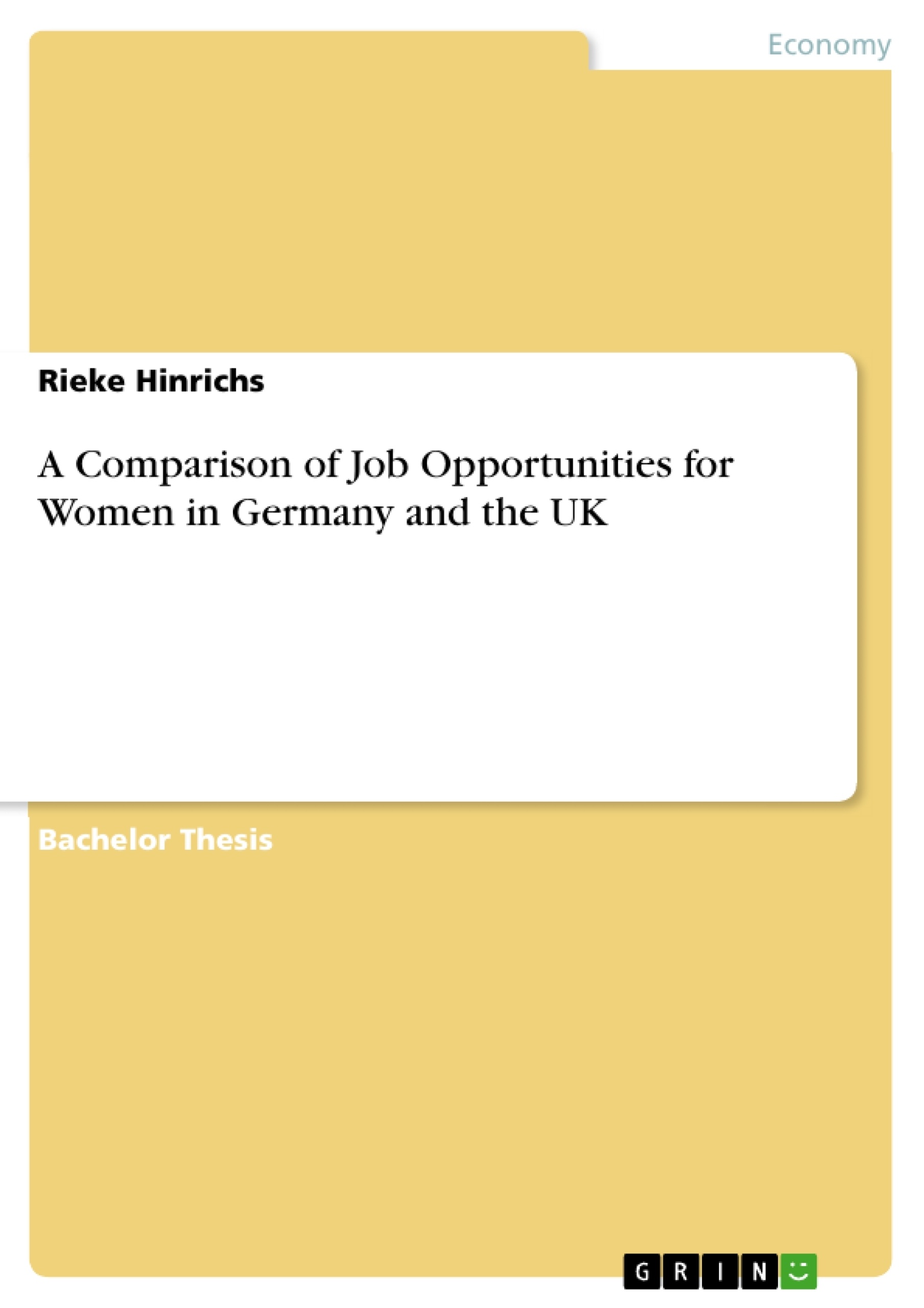The purpose of this project was to analyse to what extent gender equality has been
achieved, which barriers still exist in female employment and to evaluate opportunities
for women in the UK in comparison to those in Germany. The author reviewed a wide
array of sources, such as studies, laws and articles, but the main analysis was done on
the basis of extensive data that has been collected by the OECD and the World
Economic Forum. Based on those findings, gender gaps concerning labour force
participation, occupational sectors and types of work as well as wages and pensions
were identified for both countries. More specifically this paper provides information on
the main barriers for women in employment, the most important of which are maledominated
corporate cultures and discrimination. Especially mothers experience
barriers, like the lack of affordable childcare, insufficient flexible working options, or the
fact that people who use those are disadvantaged as well as unequal contribution of
unpaid work and childcare, despite laws that allow fathers to participate more in family
life. During the whole project, the applicability of theories such as the ‘Glass Ceiling’,
the ‘Sticky Floor’ or the ‘Opt-Out Revolution’ has been tested in order to identify
reasons for inequality. Furthermore, measures which have already been taken against
the existing barriers were described, and some that could be taken in the future were
suggested. Differences between conditions for women in Germany and the UK have
been analysed, compared and evaluated, with the result that the UK offers slightly
better chances, but both countries achieve quite different results in particular
categories. Depending on which aspects a woman puts emphasis on, this thesis can
help to decide which country is best to live and raise a family in.
Inhaltsverzeichnis (Table of Contents)
- I. STUDENT DECLARATION
- II. ABSTRACT
- III. TABLE OF CONTENTS
- IV. LIST OF FIGURES
- 1. INTRODUCTION
- 1.1 BACKGROUND
- 1.2 AIMS, RESEARCH QUESTION AND OBJECTIVES
- 1.3 SCOPE
- 2. LITERATURE REVIEW
- 2.1 HISTORY
- 2.2 LAW
- 2.2.1 Equal Pay Act and Sex Discrimination Act
- 2.2.2 Parental Leave and Parents Money
- 2.3 EQUALITY
- 2.4 POLITICS
- 2.5 HUMAN RESOURCES
- 2.5.1 The 'Glass Ceiling'
- 2.5.2 The 'Leaky Pipeline'
- 2.5.3 The 'Sticky Floor'
- 2.5.4 The 'Opt-Out Revolution'
- 2.5.5 'Work-Life Balance' and 'Work-Life Conflict'
- 2.5.6 The 'Maternal Wall'
- 3. METHODOLOGY
- 3.1 RESEARCH FAMILIES
- 3.1.1 Primary and Secondary Data
- 3.1.2 Qualitative and Quantitative Data
- 3.2 KEY CONcepts
- 3.2.1 Validity
- 3.2.2 Generalisability
- 3.2.3 Reliability
- 3.2.4 Triangulation
- 3.3 ETHICAL PRINCIPLES
- 3.1 RESEARCH FAMILIES
- 4. PRESENTATION OF FINDINGS
- 4.1 MAIN SOURCES USED FOR THIS DISSERTATION
- 4.2 EQUALITY IN EMPLOYMENT – GENDER GAPS IN GERMANY AND THE UK
- 4.2.1 Economic Participation and Opportunity
- 4.2.1.1 Labour Force Participation
- 4.2.1.2 Wage Gap
- 4.2.1.3 Pensions Gap
- 4.2.1.4 Occupational Segregation
- 4.2.2 Differences in Types of Work
- 4.2.2.1 Women in Management and on Boards
- 4.2.2.2 Part-time Work and Unpaid Work
- 4.2.1 Economic Participation and Opportunity
- 4.3 LEGAL AND NON-LEGAL CONSTRAINTS/BARRIERS
- 4.3.1 Corporate Culture and Employer Policies
- 4.3.2 Motherhood and the Re-Entry into Employment
- 4.3.3 Work-Life Conflict and Childcare
- 4.4 LEGAL AND NON-LEGAL PROVISIONS FOR WOMEN
- 4.3.4 (Lack of) Flexible Work Solutions
- 4.4.1 Reducing Occupational Segregation
- 4.4.2 Changing Corporate Cultures & Reducing Stereotyping
- 4.4.3 Introduction of Quotas
- 4.4.4 Introduction of Parental Leave and Parents Money
- 4.4.5 Creating Awareness
- 4.4.6 Childcare & Flexible Working Arrangements
- 4.4.7 Measures against Pay Discrimination
- 5. CONCLUSION
- 5.1 WHY HAS GENDER EQUALITY NOT BEEN ACHIEVED?
- 5.2 WHICH COUNTRY OFFERS MORE GENDER EQUALITY and Hence Better OpporTUNITIES FOR WOMEN?
Zielsetzung und Themenschwerpunkte (Objectives and Key Themes)
This dissertation aims to analyze the extent of gender equality in the workplace, identify barriers that women face in both Germany and the UK, and compare the opportunities available to women in each country. The author utilizes a wide range of sources including studies, laws, and articles, with a particular focus on data collected by the OECD and the World Economic Forum.
- Gender equality in employment
- Barriers to female employment
- Comparison of opportunities for women in Germany and the UK
- Impact of corporate culture and discrimination on female employment
- Measures to promote gender equality in the workplace
Zusammenfassung der Kapitel (Chapter Summaries)
- Introduction: The introduction sets the context for the dissertation by discussing the background of gender equality, defining the research question and objectives, and outlining the scope of the study.
- Literature Review: This chapter explores the historical and legal context of gender equality, examining relevant legislation, theories, and concepts such as the 'Glass Ceiling,' 'Sticky Floor,' and 'Opt-Out Revolution.' It delves into the complexities of achieving equality in the workplace, highlighting the impact of politics, human resources practices, and societal norms.
- Methodology: This chapter explains the research methods employed in the dissertation, outlining the types of data used, the key concepts applied, and the ethical principles adhered to throughout the research process.
- Presentation of Findings: This chapter presents a detailed analysis of gender gaps in Germany and the UK, focusing on economic participation, occupational segregation, types of work, and legal and non-legal barriers faced by women. It examines the effectiveness of measures aimed at promoting gender equality in both countries.
Schlüsselwörter (Keywords)
The key terms and concepts explored in this dissertation include gender equality, female employment, occupational segregation, wage gap, corporate culture, discrimination, legal frameworks, work-life balance, flexible working arrangements, and childcare provisions. The dissertation investigates the impact of these factors on women's opportunities in both Germany and the UK.
- Quote paper
- Rieke Hinrichs (Author), 2013, A Comparison of Job Opportunities for Women in Germany and the UK, Munich, GRIN Verlag, https://www.grin.com/document/274677



